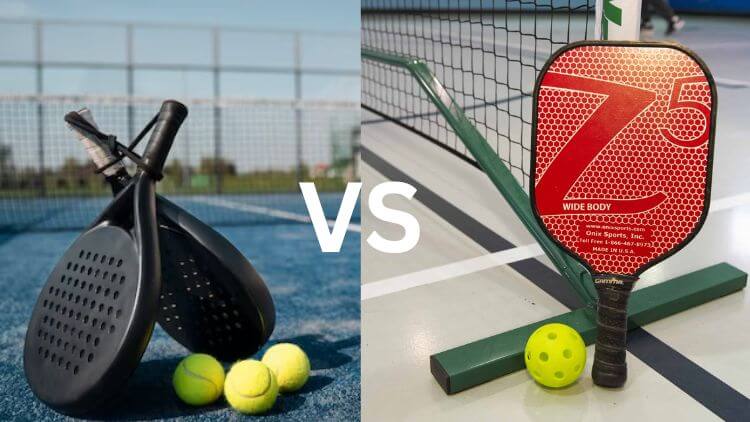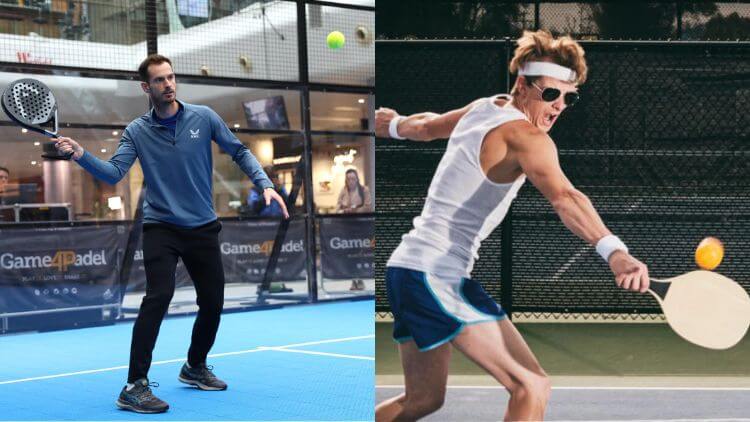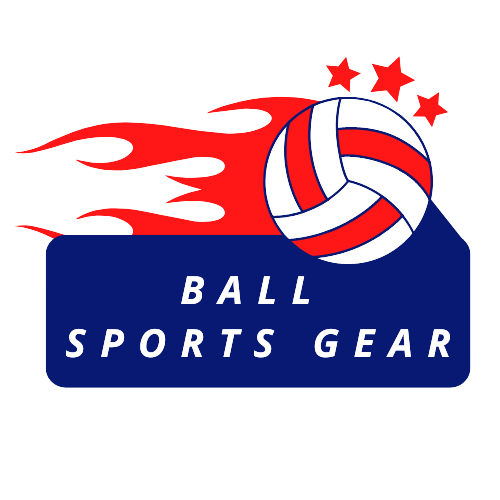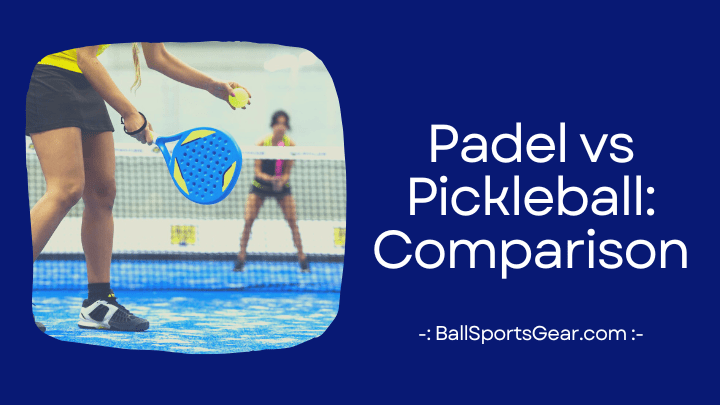Two increasingly well-liked racket sports, pickleball vs padel, provide different and thrilling experiences for participants of all ages and ability levels. Although paddles and balls are used in both sports, there are significant differences between them in terms of the laws, court size, scoring methods, gear, and techniques. In order to help you better understand both exhilarating games and assist you in selecting the one that best matches your tastes and playing style, in this post we will compare and contrast padel vs pickleball.
What Is Padel?
Padel, also known as padel tennis, is a racket sport that originated in Mexico in the late 1960s. It has gained immense popularity in Europe, particularly in countries like Spain, Argentina, and Mexico. Padel is played on an enclosed court with glass walls, similar to a combination of tennis and squash.
The objective of padel is to score points by hitting the ball over the net and into the opponent’s court in a way that makes it difficult for them to return the shot. The unique aspect of padel is that the walls are considered part of the game, allowing players to use them to keep the ball in play and create strategic shot angles.
Padel is typically played in doubles, with teams taking turns to hit the ball. The serve is executed underhand, and the ball must bounce on the ground before hitting any of the walls. This feature adds an exciting element to the game, as players need to anticipate and react to the ball’s trajectory after it bounces off the walls.

What Is Pickleball?
Pickleball is a relatively new racket sport that was created in 1965 in the United States. It combines elements of tennis, badminton, and table tennis, making it a unique and fast-paced game. Pickleball has gained significant popularity, particularly in the United States, where it is considered one of the fastest-growing sports.
Pickleball is played on a smaller court compared to traditional tennis, making it accessible to players of all ages and skill levels. The court is divided into different zones, including a non-volley zone near the net, often referred to as the “kitchen.” The non-volley zone prohibits players from hitting the ball in the air while standing inside it, promoting strategic shot placement and touch around the net.
Players use solid-faced paddles to strike a perforated plastic ball over the net during doubles or singles matches of the game. However, the ball cannot be volleyed from the non-volley zone. The ball can be hit both in the air and after it bounces on the ground. Pickleball has brisk rallies and calls on quick reflexes, agility, and accurate shot placement.
Pickleball has a unique scoring system where points can only be scored by the serving team, and games are usually played to 11 or 15 points. The sport offers an inclusive and social environment, attracting players of all ages and skill levels.
Padel vs Pickleball: Comparison
Padel and pickleball are two distinct racket sports with their own sets of rules, court dimensions, and gameplay styles. Padel is played on an enclosed court with glass walls, while pickleball is played on a smaller court with a non-volley zone. Both sports offer unique and exciting experiences for players of all levels.
- Rules of Play
Padel: In padel, the ball must bounce on the ground before hitting any of the walls. The walls are considered part of the game, and players can use them to keep the rally going. Padel is typically played in doubles, and the serve is executed underhand, with the ball needing to bounce once before being hit.
Pickleball: Pickleball allows both ground strokes and volleys. The ball can be hit in the air or after bouncing on the ground. However, there is a non-volley zone, commonly referred to as the “kitchen,” where players cannot volley the ball. Pickleball can be played in doubles or singles, and the serve is executed underhand as well.
- Court Dimensions
Padel: Padel is played on a rectangular court with dimensions measuring 20 meters in length and 10 meters in width. The court is enclosed by glass walls, which are used as part of the game. Padel courts are designed to provide exciting angles and strategic shot placement opportunities.
Pickleball: The pickleball court is significantly smaller than a padel court. It measures 13.4 meters in length and 6.1 meters in width. The court is divided into different zones, including the non-volley zone, which extends 2.7 meters from the net. The smaller court size allows for faster-paced gameplay.
- Scoring
Padel: Padel uses a scoring system similar to tennis, with points awarded as 15, 30, 40, and game. However, unlike tennis, padel employs no-advantage scoring, meaning that if the score reaches deuce (40-40), the next point wins the game.
Pickleball: Pickleball has a unique scoring system. Only the serving team can score points, and they can only score when they are serving. Games are typically played to 11 or 15 points, and the winning team must win by at least two points.

- Equipment
Padel: Padel rackets are solid with no strings. They have a perforated surface and are typically made of composite materials. The balls used in padel are similar to tennis balls but are slightly less pressurized.
Pickleball: Pickleball paddles are solid-faced and are usually made of materials such as graphite or composite. They are larger than table tennis paddles and smaller than traditional tennis rackets. The ball used in pickleball is perforated and resembles a wiffle ball, with holes to slow down its flight.
- Techniques
Padel: Padel emphasizes teamwork and strategy. Players must master shot placement, control, and court positioning to outmaneuver their opponents. The use of the walls adds a unique element to the game, requiring players to anticipate and execute shots creatively.
Pickleball: Pickleball needs agility and fast reflexes. Players emphasise strong groundstrokes and dinking, which includes delicately dropping the ball over the net. The “kitchen,” or non-volley zone, necessitates deft placement and touch close to the net.
Frequently Asked Questions
Yes, both sports are accessible to beginners. Padel’s enclosed court and forgiving walls make it easier to keep the ball in play, while pickleball’s smaller court size and slower pace cater to players of all ages and skill levels.
Padel has gained significant popularity in Europe, particularly in countries like Spain, where it is considered the second most popular sport after soccer. Pickleball, on the other hand, has experienced exponential growth in the United States and is rapidly spreading internationally, including in countries like Canada, Australia, and the United Kingdom.
Both padel and pickleball are popular among older players due to their accessibility and lower impact on joints compared to some other sports. However, pickleball’s slower pace and smaller court size may be more accommodating for older players looking for a less physically demanding option.
Yes, both padel and pickleball can be played in both singles and doubles formats. However, doubles is more common in both sports, and the rules and strategies may vary slightly between singles and doubles play.
No, padel and pickleball require different equipment. Padel is played with solid rackets similar to tennis rackets, while pickleball is played with solid-faced paddles that are larger than table tennis paddles. The balls used in each sport also differ in size and composition.
Conclusion
In conclusion, Padel vs Pickleball are two dynamic racket sports that have captivated the interest of players around the world. While padel combines elements of tennis and squash, played on an enclosed court with glass walls, pickleball integrates aspects of tennis, badminton, and table tennis, played on a smaller court with a unique non-volley zone. The rules, court dimensions, scoring systems, equipment, and techniques in padel and pickleball present distinct characteristics and challenges, offering players diverse experiences on the court.
Whether you are drawn to the strategic shot placement and teamwork of padel or the fast-paced rallies and reflexes required in pickleball, both sports Padel vs Pickleball provide opportunities for enjoyment, fitness, and friendly competition. So, grab a paddle, step onto the court, and embark on an exciting journey with padel or pickleball, discovering the exhilaration and camaraderie these sports have to offer.

